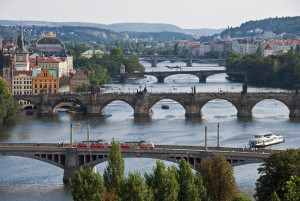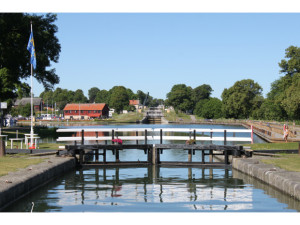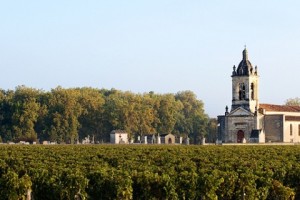Part 2 of a 3-part series
In our last post, we began our quick guide to European cruising rivers, starting with the Danube, Rhine, Seine, and the Volga and other Russian waterways — probably the best known of the top 12 cruising rivers in Europe.
In this post, we’ll take a look at four more rivers — well, actually five rivers and one canal — ranging from France to Portugal, Germany and the Czech Republic to Sweden.
The Rivers of Bordeaux: the Dordogne, Garonne, and Gironde
You can get an intimate look at Bordeaux, perhaps the world’s premier red-wine-producing region, on this three-river cruise that begins in the city of Bordeaux itself. Bordeaux, situated along the Garonne River — which connects to the Bay of Biscay via the Gironde River along France’s western coast — is a treasure trove of architectural monuments and has been named a UNESCO World Heritage Site.
Once at sail, a short trip northwest on the Garonne and then onto the Gironde River and estuary leads to the town of Pauillac, offering a chance to explore the Medoc region — known for its premium red wines and the Châteaux Lafite-Rothschild. Another frequent stop is Blaye, also on the Gironde Estuary, which is the site of a UNESCO World Heritage citadel.
Next, it’s time to head to a third river, the Dordogne, which snakes east into the interior of the country. One excursion option is the medieval city of Saint-Émilion, a World Heritage Site northeast of Bordeaux, known for both its Romanesque churches and its long history of wine production. The cruises then retrace their journey back to Bordeaux with a stop in Cadillac on the Garonne River, where you can tour châteaux and taste the local Sauternes dessert wines.
Portugal’s Douro
If you have a taste for port wine, or just want to drift past some beautiful countryside and explore small villages that are off the beaten track, cruising through the Douro Valley may be your ticket. The river flows from north central Spain into Portugal and runs to the delightful hillside city of Porto, the cradle of port wine, where it ends at the Atlantic Ocean.
The Douro River cruises themselves are limited to the Portuguese part of the river (though most include a side trip to culturally rich Salamanca, known as Spain’s “golden city”), so you’ll enjoy a slow, leisurely sojourn with plenty of time to sample the local wines and wander through atmospheric towns along the Port Wine Route.
These may include Lamego, site of a pilgrimage church; Pinhao, where you can sip port wines while drinking in panoramic views as well; and Castelo de Rodrigo, a fortified hilltop city with cobblestoned streets and castle ruins. Roundtrip cruises from Porto typically last six to eight days.
The Elbe

Prague is a frequent destination on an Elbe River cruise, though it lies on the Vltava River. Photo from Dennis Cox/WorldViews
Some of Europe’s greatest Eastern European cities — Berlin, Dresden and Prague – are on vibrant display during an Elbe River cruise. Berlin and Prague, once neglected parts of the Soviet bloc, are now two of the hottest destinations on the planet, while the old section of Dresden, devastated by firebombing during World War II, has been painstakingly rebuilt just as it was before the war — and is now a showplace.
The Elbe starts in the Czech Republic and ends at Germany’s North Sea, near Hamburg, but the actual week-long cruising segment runs between the towns of Magdeburg, Germany, and Melnik in the Czech Republic.
Besides Dresden, typical stops include Wittenberg, where Martin Luther lived and, in 1517, nailed his 95 Theses to the door of a local church, igniting the Protestant Reformation that changed Europe forever; the porcelain-producing city of Meissen; and Litomerice, a Czech town dating from the 12th century. Itineraries typically include time in Berlin and Prague at the beginning and end, which can lengthen the entire Elbe journey to ten days.
Sweden’s Göta Canal
The Göta Canal is Sweden’s most enduring popular attraction, a wondrous combination of natural beauty and human engineering. Joining with lakes, rivers, the sea and smaller canals to form a continuous waterway across the country, the Göta links the North Sea city of Göteborg in the west with Stockholm on the Baltic, 360 miles to the east.

The Göta Canal passes through a series of locks and drawbridges as it crosses Sweden. Photo from the Göta Canal Steamship Co.
Completed in 1832, the 115-mile canal section — known affectionately as “Sweden’s Blue Ribbon” — includes 65 locks, some of which are still operated by hand.
A full four-to-six day voyage from Göteburg to Stockholm takes you through an ever-changing panorama of the Swedish countryside: fields and farmlands, vast lakes and deserted islands, medieval castles and primeval forests.
The classic cruises are operated by the Göta Canal Steamship Company, whose ships still evoke an era of romantic Continental travel. One, the 1874-vintage M/S Juno, is the world’s oldest registered ship offering overnight accommodation; keep in mind that the ships are narrow to fit in the locks, so cabins are “cozy.”
Stops, which vary with the cruise, may include the villages of Trollhätten, home to the Canal Museum; Forsvik, site of the canal’s oldest and highest lock; and Berg, which features one flight of seven locks and two double locks. Other excursions may take you into the medieval towns of Vadstena and Söderköping and the Viking community of Birka, Sweden’s first town.
You’ll also pass through Lakes Vänern and Vättern and spend some time in the Baltic Sea along the Swedish coastline on the way to or from Stockholm (ships travel in both directions between Stockholm and Göteborg). Göta Canal cruises are available primarily from the end of May through August.
Coming in Part 3: Spain’s Guadalquivir, Germany’s Moselle, Italy’s Po, and France’s Saône and Rhône
An earlier version of this post appeared in StrideTravel.com, the premier online site for finding the best organized travel around the world.














2 Responses to A Quick Guide to Top European River Cruises